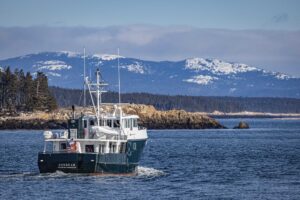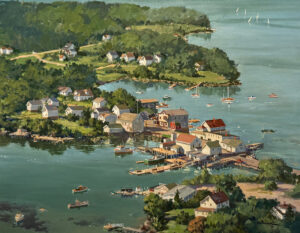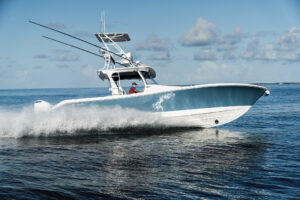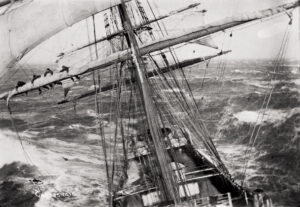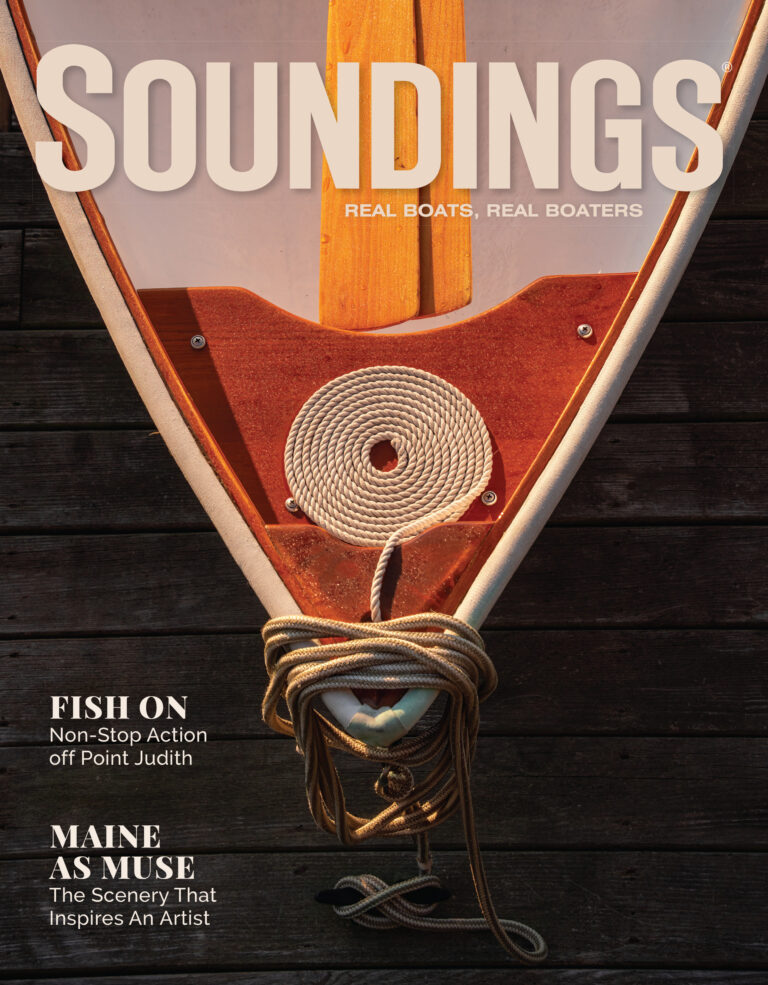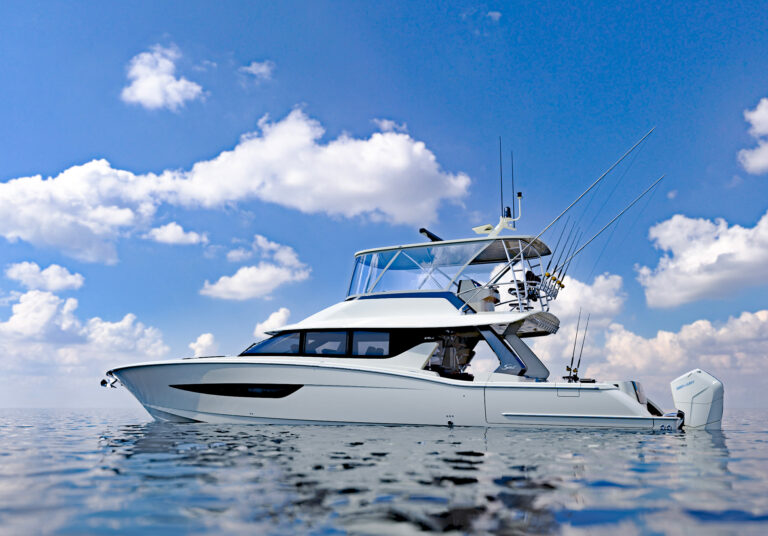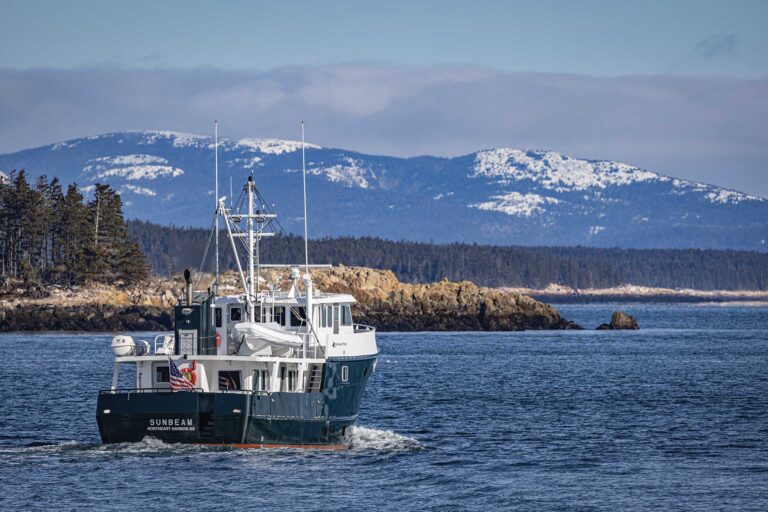You can finish “oldest woman to …” several ways, but that’s not what motivates solo circumnavigator Jeanne Socrates
At first, the boat is a hazy outline on the horizon. Framed by the snowcapped Olympic Mountains, her contours fade in and out of the mist that blankets the Strait of Juan de Fuca, a cold and often treacherous body of water that separates the United States from Canada.

Soon, the details emerge: It’s a sloop sailing before the brisk westerly, her sails spread wing-on-wing as she heads for the light that marks the dangerous shoals of Race Rock. She’s cutting a nice wake, but she’s scarred from her bouts with the ocean. Her bottom is covered with algae and barnacles; her formerly pristine hull is stained with oxidation. Rips in the genoa and torn-off instruments made fast with pieces of line to the cockpit arch bear witness to the brute force of nature.
At the wheel, behind the dodger of that battered boat named Nereida, stands Jeanne Socrates. She’s wearing weathered foulies and a knitted Canada-beanie that’s pulled over her forehead to ward off the chill. She looks tired, but her face brightens to a smile as she waves to greet the first people she’s seen at close range after months of solitude at sea — a courageous voyage that took the 71-year-old British solo sailor around the globe without stopping or receiving assistance of any kind.

Delayed by fickle winds, the finish demands patience above anything else — from the skipper, who’s been battling storms and calms, but also from friends and fans, who are full of anticipation, and two intrepid reporters who sailed out for a couple of hours on a racing trimaran to witness sailing history in the making.
It was about 2:20 a.m. on July 8, 2013, when Socrates drifted across the finish line in Victoria, British Columbia, the place she likes to call home, where she’d started her circumnavigation 259 days before. A few people on the breakwater waved light sticks, and some horns blared in the dark as she calmly rolled away the jib and took down the main that was stuck on the second reef because of a defective mast track. An official of the Ocean Cruising Club stepped aboard to congratulate her and check the seal of the drive shaft to verify that she hadn’t used the engine for propulsion.
When she docked Nereida — a stock Najad 380 — in front of Victoria’s famous Empress Hotel, there was no music, no branding, no TV coverage and no crowd. “Canada is not a sailing nation, you know,” someone said apologetically. “Besides it is a tad late.”
This isn’t France, where solo sailing is a matter of national interest. But Socrates is 71, not 17, which carries a penalty in a youth-obsessed culture. She wasn’t even allowed to step off the boat because she hadn’t cleared Customs yet. But she was in good spirits, talking to a handful of supporters who had assembled dockside. “Going around is great, and I enjoyed it, but I don’t feel any different,” she says, sipping organic champagne from a paper cup that was handed to her. “It’s still me, you know.”
This was her third full circumnavigation, although she’s probably racked up enough miles for four with her other voyages. It was also shorter than the previous two, she says, covering “only” 25,000 miles. It was monitored by the World Sailing Speed Record Council, even though age-related records are no longer officially kept.
This humble widow and grandmother put to shame the teenagers who commanded the spotlight a few years ago for their solo voyages. Australian Jessica Watson, who was 17 when she finished in May 2010, was the only one to complete an unassisted non-stop journey. But unlike Socrates, her voyage did not meet the criteria of the WSSRC to qualify as a true circumnavigation. Still, Watson, American Zac Sunderland and Brit Mike Perham, who both skipped Cape Horn in favor of the Panama Canal on their supported voyages, were feted like heroes by thousands of spectators at the finish.
So let’s talk about age and achievement: Socrates is the oldest woman to sail around the world alone and the oldest to do so non-stop and without outside assistance. She is also the oldest woman to circumnavigate via the five great capes (on a previous attempt), and she’s the first woman to go solo and non-stop with a start and finish in North America. But the hoopla about the number of candles on her birthday cake doesn’t impress her. “Age should be irrelevant,” she says. “As soon as you mention it, people become very ageist and categorize you: ‘Oh, she’s finished,’ or whatever.”

Finished? Socrates? You’re kidding. She’s the consummate iron lady of bluewater sailing. Twice before, she’d attempted a solo, non-stop voyage but had to run for shelter and repairs. In 2009, she was forced to stop in Cape Town, South Africa, to fix a damaged rig, and in 2011, she had to stop in Ushuaia, Argentina, after getting knocked down in a storm on her approach to Cape Horn. Both times she continued afterward but with stops.
And in 2008, at the end of her first “cruising-style” circumnavigation, she wrecked 60 miles before she was going to cross her outgoing course line, which would have closed the loop mathematically. She was resting in her bunk during a calm stretch along Mexico’s west coast when the autopilot went crazy and steered her onto the beach. It was the end of her boat and her voyage but not the end of her story. “I was saving things off the boat with a view to put them on the next one,” she says. “It never occurred to me that I would not be on another boat.”
Ironically, the last trip, her shortest, seemed to take forever. “I was saying if I’m lucky it will be seven months; if I’m unlucky it will be eight,” she jokes. “Now here I am after eight and a half.” Her best daily distance was only 167 nautical miles.
Often, she says, pointing to her meticulously kept logbook, the GPS read “zero point zero.” Even the Horn served up glassy seas this time, but Socrates wasn’t allowed to relax because there were reports of ice. She escaped this threat by using routing information passed to her by the Vendee Globe fleet that had sailed through this area shortly before her. Still, plenty of stuff broke. A pin for the lower shroud fitting on starboard came loose, which she realized when she heard it rolling around on deck. Her wind generator and radar were carried away in a knockdown in the Southern Ocean, and the wind vane of her self-steering system came loose. She contemplated pulling into a remote bay on Tasmania to anchor and fix it, but one of those many unexpected calms came to her aid. She jumped overboard and dealt with it.
She knew she could handle what nature threw at her, but the equipment let her down. “You’re not going to succeed in anything like this if you’re not aware that you’re going to have problems and you’ll have to face up to them,” she says. But that’s just her thing. “You’re using everything on the boat so intensively all the time, so if anything goes wrong, you’ve got to fix it, do without or give up. And I don’t give up.”
The weakest link, Socrates says, was technology, especially electronics. Among other things, her sat phone quit, and later her computers went down, which meant she couldn’t send email from the boat. Ham radio operators around the world, who followed her trip, set up and monitored a temporary email address for her. They read incoming messages to her and transcribed her replies before sending them. Rick Williams handled her blog posts and came to meet her in Victoria. “There were many moments when I thought she was crazy,” he says. “Even though she was sailing around the world alone, she found time to spell out the nautical terms and correct the spelling of birds’ names. At one point she told me, ‘This is not a comma but a semicolon.’ Once a teacher, always a teacher.”
Socrates’ strength, perseverance and independence were not genetic gifts. Born on Aug. 17, 1942, she grew up in Stepney, a blue-collar borough on London’s east side, as an only child. Her father was killed in the war, and her mother struggled to make ends meet. “We were very poor. I had an outside toilet and a potty under the bed and this kind of thing,” Socrates says.
When she was 5, her mother saw no other way out than putting her into an orphanage. “I became used to being alone,” she recalls. “You are keeping your own company because you haven’t got family around. You learn to be more self-reliant.” When Socrates was 9, her mother remarried, and she found her stepfather a “brilliant man.”
She later studied mathematics and nuclear physics — “but math was always my first love” — hitchhiked through Greece and Turkey, and met her future husband, George, also a teacher, at a wine tasting. She taught at the university level for 10 years but later found a position at a private boys’ high school where she also led extracurricular student activities, including dinghy sailing and boardsailing, which she took up when she was nearing her 50th birthday. And cruising? “I thought it was totally boring,” she says. “When you come back from Laser sailing or windsurfing and you see these guys coming in on their yachts, ‘Look at me and my boat, aren’t I great?’ That’s not for me.”
But when an opportunity arose in 1994, she and her husband took a five-day “competent crew course” on the Solent. The weather was great, the wind was great, and they were hooked. Both were numbers-nerds, so navigation was a cinch, more or less. Getting up to snuff with the practical side was a different story, but eventually they both got licensed. She even got an RYA Yacht Master Ocean qualification, fixing positions with a sextant during an Atlantic crossing in 1999.
The couple bought a Najad 361 center cockpit cruiser, the first Nereida, which they co-captained during trips in the Med and later, after retirement, in the Caribbean. But their time together at sea was limited, as George succumbed to cancer in 2003. “After his passing, sailing was my comfort,” Socrates says. It was her way of honoring the memory of her dearly departed mate. With her last trip, Socrates also raised funds to support non-profits, including Marie Curie Cancer Care.

She got her start as a solo sailor when her crew didn’t show up for a passage from Bonaire to Curaçao. “I was not going to wait indefinitely for someone to come along, to hell with it,” she says. She says she doesn’t have a big desire to sail solo, but she doesn’t mind, either. “If I have to be by myself to go sailing, then so be it. I can do everything I need to do.”
Around noon on the day of her return from this circumnavigation — customs had cleared her — she held an improvised dockside press conference while standing on Nereida’s deck. Afterward she gave a private tour of the boat, pointing out the carnage and explaining such nifty details as the Spectra lines she strung from the mast to the shrouds to keep the halyards from fouling on the footholds.
“I should go up there to look at the wind instruments,” she says. How about sending up a technician? “No, no, that’s my business. How else am I going to find out what went wrong?” Seemingly endless curiosity is another of Socrates’ strong suits. Wanting — and needing — to understand how things work once led her to take a hands-on tutorial in advanced engine maintenance in Alaska. So Socrates can discuss advanced math or nuclear physics and rip apart a defective diesel to fix the injectors.
“Jeanne dreamed big and did everything to make it reality,” says Charlotte Gann, one of Socrates’ friends in Victoria. “Her achievement is perhaps less gender-specific and more inspired by a spirit and desire to push beyond existing boundaries — a philosophy that would serve each of us well.”
Listening to her detailed narrative, there is little doubt that Socrates has been prepping all of her life, perhaps inadvertently, to become the world’s oldest female solo non-stop circumnavigator. Along her circuitous journey, she methodically acquired the requisite skills and knowledge and refused to call it quits after two failed attempts. That’s why this septuagenarian reached the summit of solo sailing’s Mount Everest.
At 5 feet, 4 inches, she’s not an imposing physical presence, yet she is standing in the company of giants like Frenchmen Bernard Moitessier and Francis Joyon, or fellow Brits Sir Robin-Knox Johnston and, especially, Dame Ellen MacArthur, who inspired her.

Since the trip, Socrates has had some R&R and started to whip the battered Nereida into shape with the support of the boating community on Vancouver Island and members of the Royal Victoria Yacht Club. She’s also been back to London for family business, media appearances and to haggle with police about an old speeding ticket. But she isn’t done. She’ll cast off again — soon and solo, as she hinted. Not for any records but to visit people around the world who helped and have become friends.
So she’ll point Nereida’s bow westward again, as she sails out the Strait of Juan de Fuca, rounding the shoals of Race Rock. Why? The answer is simple: because she has to. Or as she puts it, “That’s the life I enjoy most.”
February 2014 issue


